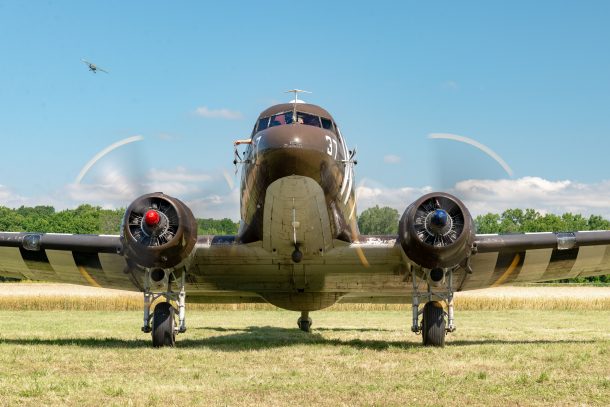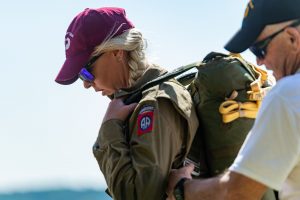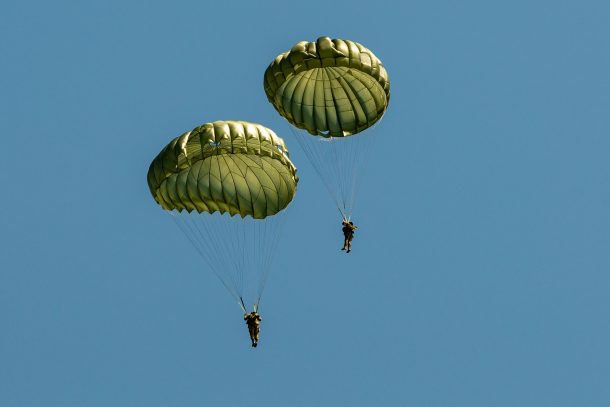‘Whiskey 7’ a Rugged Reminder of D-Day
D-Day Veteran “Whiskey 7” stands glimmering in the twilight at the National Warplane Museum. (Anthony C. Hayes)
They’re not as sleek as the storied Mustangs which once ruled the skies over Germany, nor as famous as the Flying Fortresses that took the fight far behind enemy lines. But for thousands of Allied paratroopers in the pre-dawn hours of D-Day, the hardy C-47 was their elevated stepping stone into World War II.
Nearly 850 C-47 “Skytrains” crossed the English Channel on D-Day, delivering troops, munitions, medicine, and supplies, while (in some cases) simultaneously towing transport gliders. Their mission over Europe (as well as in every other theatre of operation during the war) would also include medical and strategic evacuations, search and rescue missions, general transport duties, and support for resistance fighters and clandestine operators.
Ten thousand C-47s were produced at factories in California and Oklahoma during the war. And a surprising number of those sturdy Skytrains remain. We had a chance to see four of them at the 2019 National Warplane Museum Airshow, and go up in one that made that momentous flight across the English Channel on D-Day: The “Whiskey 7.”

(Anthony C. Hayes)
“‘Whiskey 7′ was built in 1943 by Douglas Aircraft in Long Beach, California,” explained Pilot Craig Wadsworth – Director of Maintenance and Restoration at the National Warplane Museum. “It was delivered to the Army Air Corps that very same year and served for the rest of the war in the European Theatre.
“She was the lead ship of the 18th Serial, which was the second wave over Normandy on D-Day. She also flew during Operation Market Garden – the invasion of Holland – and Operation Varsity, which was the invasion of the German homeland in 1945.
“After the war, she served as a passenger and cargo transport, before coming to the National Warplane Museum in 2009. Currently, we take her to events all over the east coast as an educational outreach tool to teach people young and old about World War II, aviation technology, and the sacrifices we and our Allies made in winning the war.”
We were somewhat surprised to learn that “Whiskey 7″ was a veteran of so many historic flights. We asked Wadsworth if that affects the way she is used by the National Warplane Museum.
“We track hours, not flights, so we fly 70-90 hours per year, which is a good number. We’d like to fly her more because the more she runs, the more she likes it. I would really like to see us doing 100-150 flight hours per year.
“Right now, the airframe has some 59,000 flight hours on it, which turns into 6 years and 9 months off the ground since she was brand new. She carries her original engines, which are Pratt and Whitney R-1830. Full power they make 1200 horsepower.”
Is “Whiskey 7″ a snowbird?
“No,” said Wadsworth. “She lives up here year-round, so she doesn’t follow the sun. During the winter months, we do our maintenance inspections and try to do a few restoration items to try to bring her back to her D-Day configuration.”

Climbing into the plane, the first things you’re aware of are the canvas bench seats that hug the fuselage. This simple seating configuration would allow paratroopers plenty of space for their gear without impeding their appointed deployment. Overhead, you can see and touch the taut steel cable to which the paratroopers attached their chute’s crucial static line. Absent the static lines, the cable offers ready support for moving about the plane.
Our thirty-minute flight took us over some of the same ground we had covered in “The Movie” Memphis Belle. But the openness of a C-47 provides passengers more elbow room than one has on a heavily-armed B-17. There is plenty of noise, of course, and a feeling like you are in a boxcar – rolling along an ever-curving track. Hence, the apropos moniker: “Skytrain.”
As for the view – the exit door remained closed for our entire ride, but a dozen windows provided pleasing vistas for the picture-taking crowd. The view from just behind the cockpit was equally exciting – not that the occupants headed to Normandy in 1944 were concerned with such pedestrian things.

(Anthony C. Hayes)
The paratroopers that dark June morning wanted to get post-haste to their drop-zones. The crew wanted to get the plane safely to its destination and back to its base in England.
Our destination was purely bucolic so get back we did – to the Geneseo airfield – with the cheers from the ground mostly muted by the roar of the Pratt & Whitney Wasp engines.
Niagara County residents Kelli and Jeff were elated they made the mid-morning flight.
“We’re glad we came out today,” began Kelli. “We come to the airshow every year and try to support it with the purchase of souvenir gear. Two years ago, they had a fundraiser for the ‘Whiskey 7′ to return to Normandy. We came for that, and it was a beautiful event – they did a really nice job. Everyone was dressed in 40s-era attire for a hangar dance. After that, we got to see her off.
“Jeff surprised me the other night with this flight. I saw him sitting at the computer, printing out our tickets. He said, ‘We’re going for a ride on the Whiskey 7,’ so it was a very nice surprise.”
“I was an Army Military Police Officer for three years in Germany and Ft. Campbell, Kentucky,” said Jeff, “then followed that period of active duty in the reserves for a few more years.”
We asked Jeff if he had quickly reflected on his time across the pond while flying in a plane which saw action over Europe 75-years ago.
“When I was in Germany, thirty-some years ago, the Berlin Wall was still up, so it was different. Today, folks are free to travel. Back then, you had to be careful where you walked.”
Autumn Waters could answer the question of why a reporter from Baltimore would travel to Geneseo to cover an airshow. Autumn made a similar drive with her mother and brother from their home in Pasadena, Maryland!
“We come up here to volunteer – that was my brother with the headset in the back of the plane. So it was nice to get a chance to step away from the information table and take a ride today. I really enjoyed it! I’ve been on an international flight, but it’s way different to fly on a historic plane. I’m into US history and lean toward WWII and the Civil War, so getting to fly today in the ‘Whiskey 7′ was something special,” said Autumn.
“Keeping History Alive”

With a long line of eager, casually-clothed passengers, it might be easy to forget the significant role the “Whiskey 7″ played during the course of the war. Fortunately, the Liberty Jump Team was on hand and prepared to fulfill its mission of “Keeping History Alive.”
“I started jumping when I was 21 years old,” said team member Denny Archer. “That was 50-some years ago. I quit doing it about 30 years ago, then came back about 5 years ago.”
What brought Archer back?
“Oh, it’s just exciting! But I was also interested in honoring veterans and keeping the airborne spirit alive in the minds of everybody that sees these shows. We were jumping from C-130s and C-141s when I was in the service, so I missed the C-47 era by about 30 years. This isn’t much different from a C-130. Both are propelled airplanes. You jump out the door and everything is pretty much the same.”
Archer said that there would be 17 members of the team jumping on that particular lift. We watched as he and his fellow team members got down to business.

(Mike Jordan/BPE)
The paratrooper’s uniform differs from the Army field uniform in a number of ways. One is with the addition of high-topped leather “jump boots” designed to give feet and ankles some extra support. Another is the cargo pocket-heavy jacket and trousers combo. Both items are reinforced to meet the demand of a tumbling lifestyle.
The most important piece of equipment, however, is the parachute. And strapping it on is definitely a team effort.
Standing below the wing of the “Whiskey 7,” we watched as Denny Archer and jump-mate Larry Ransom helped each other negotiate a series of webbed harnesses. Each waited patiently as the other tugged the loose ends of the harnesses, then carefully wove the slack in such a way that no dangling webbing was showing. Once the jump-mates completed their rather thorough inspection efforts, all of the jumpers were checked out again by Jump Master “Tater” Taylor.
“Tater was looking for any deficiencies in the rigging,” explained Archer. “It’s a final check to make sure everything is safe before exiting the aircraft.”
And safe it was, thanks to clear skies, careful preparation, flawless flying, and a parting prayer by U.S. Army Chaplain Laun.
The “Whiskey 7″ made several passes over the airfield that afternoon. Three of those passes produced the welcomed sight of billowing green and white silk. And all 17 jumpers landed without so much as a scratch.

(Mike Jordan/BPE)
Perhaps the youngest jumper that day was Yvanna Sworobowicz.
“My dad raised me with a love of military history. It was not so much about the death and horrors of war, but about the brotherhood – about the bonds those guys had. When we found the jump team, we were attracted because it’s not a reeneactment group but rather a way to keep honoring the veterans who served as paratroopers.
“So here we are.
“We’re Canadian, but we’re part of a group that is based in Texas. The group is comprised of retired and active-duty military, as well as some civilians.”
Yvanna said neither she nor her father had any military experience. But she’s been jumping for nearly a decade and had a chance to go to Normandy this year.
“We were there in June and it was amazing! It was our 4th time over there, but it’s always an honor to drop onto the same zones those guys hit 75 years ago. It’s very, very humbling.
“I’ve had a chance to meet a few of those vets,” she said, “and to be honest, it’s hard for me to talk about it even now. To know what they went through. The greatest generation – that’s special.”

* * * * *
“Whiskey 7″ is part of the permanent collection of the National Warplane Museum. She does, however, travel, and will be appearing this weekend in Conneaut, Ohio, as part of that city’s annual D-Day celebration. For more information about the “Whiskey 7″, “The Movie” Memphis Belle, and ways you can help keep these vintage warbirds flying, please visit The National Warplane Museum.

Anthony C. Hayes is an actor, author, raconteur, rapscallion and bon vivant. A former reporter at The Washington Herald and an occasional contributor to the Voice of Baltimore, Tony’s poetry, humor and prose have also been featured in Smile, Hon, You’re in Baltimore; Magic Octopus Magazine; Destination Maryland, and Tales of Blood and Roses.
